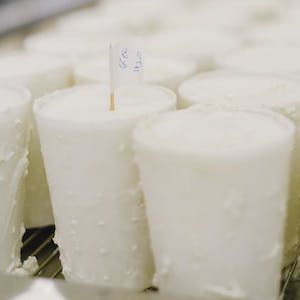Lactic acid bacteria from artisanal raw goat milk cheeses: technological properties and antimicrobial potential

Accepted: 11 September 2023
HTML: 5
All claims expressed in this article are solely those of the authors and do not necessarily represent those of their affiliated organizations, or those of the publisher, the editors and the reviewers. Any product that may be evaluated in this article or claim that may be made by its manufacturer is not guaranteed or endorsed by the publisher.
Authors
In cheese-making, a starter culture composed of adequately chosen lactic acid bacteria (LAB) may be suitable to ensure the rapid acidification of milk, improve textural and sensory characteristics, and avoid pathogen proliferation. In this work, 232 LAB isolates collected from artisanal goat’s raw milk cheeses produced in Portugal were evaluated for their antimicrobial capacity (at 10 and 37°C), as well as their acidifying and proteolytic properties. Among the 232 isolates, at least 98% of those isolated in De Man-Rogosa-Sharpe (MRS) agar presented antagonism against Listeria monocytogenes, Salmonella Typhimurium, or Staphylococcus aureus, whereas less than 28.1% of M17-isolated LAB showed antagonism against these pathogens. M17-isolated LAB displayed better results than MRS ones in terms of acidifying capacity. As for the proteolytic assay, only 2 MRS isolates showed casein hydrolysis capacity. Principal component analyses and molecular characterization of a subset of selected isolates were conducted to identify those with promising capacities and to correlate the identified LAB genera and species with their antimicrobial, acidifying, and/or proteolytic properties. Lactococcus strains were associated with the highest acidifying capacity, whereas Leuconostoc and Lacticaseibacillus strains were more related to antimicrobial capacities. Leuconostoc mesenteroides, Lactococcus lactis, and Lacticaseibacillus paracasei were the predominant organisms found. The results of this work highlight various strains with pathogen inhibition capacity and suitable technological properties to be included in a customized starter culture. In future work, it is necessary to appropriately define the starter culture and implement it in the cheese-making process to evaluate if the in-vitro capacities are observable in a real food system.
Supporting Agencies
This work was funded within the EU H2020 PRIMA Project ArtiSaneFood “Innovative bio-interventions and risk modelling approaches for ensuring microbial safety and quality of Mediterranean artisanal fermented foods” (PRIMA/0001/2018). U. Gonzales-Barron and V. Cadavez are also grateful to the Portuguese Foundation for Science and Technology (FCT) for funding PRIMA/0001/2018; and for financial support through national funds FCT/MCTES (PIDDAC) to CIMO (UIDB/00690/2020 and UIDP/00690/2020) and SusTEC (LA/P/0007/2021).How to Cite

This work is licensed under a Creative Commons Attribution-NonCommercial 4.0 International License.
PAGEPress has chosen to apply the Creative Commons Attribution NonCommercial 4.0 International License (CC BY-NC 4.0) to all manuscripts to be published.

 https://doi.org/10.4081/ijfs.2023.11559
https://doi.org/10.4081/ijfs.2023.11559



